Technology
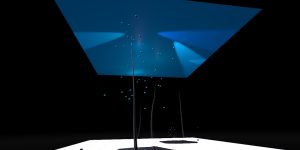
The QuBits VR Space
Jon Kulpa
Jon Kulpa is available to host a live online demonstration/performance of QuBits VR. The QuBits project is a virtual reality (VR) environment built by the composer that offers an expanded medium for musical experience with integrated space and visuals. The environment was designed to explore a musical aesthetic valuing sound mass, spatial sound, evolving sound, and algorithmically generated sonic structures. The user of the VR system plays a key role in shaping these musical elements. The user first discovers what behaviors are possible through exploration and chance encounters. They can then shape each discovered behavior with nuance if they choose. The system provides a unique experience each time it is run. The sounds are a mix of real world sampled sound, granular synthesis, and real-time generated synthetic sound.
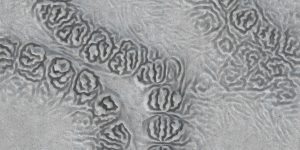
Synthesizing / Distancing - Video
UMPRUM, Academy of Arts, Architecture and Design in Prague (CZ)
Two recent installations exhibited in different locations in Prague introduce the works The Platform, by Shota Tsikoliya and David Kovařík, and Photosynthetic Landscapes, by Veronika Miškovicová, which were created at the Studio of Architecture III at UMPRUM, the Academy of Arts, Architecture and Design in Prague.
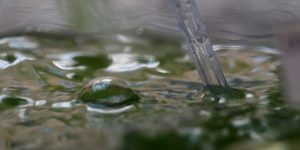
Photosynthetic Landscapes
UMPRUM, Academy of Arts, Architecture and Design in Prague (CZ)
The technologization of the natural element is a phenomenon closely connected with the present time, and in addition to the increased efficiency of plant production, it is also negatively associated with the loss of the "natural" at the expense of the "technological". What happens if these elements support each other?
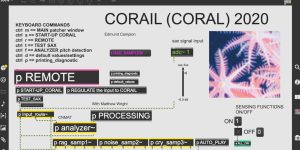
Performance of CORAIL
Edmund Campion
There is no pre-defined score for CORAIL (CORAL). CORAIL is a software environment that performs audio analysis of an incoming live signal that generates and organizes sound through the computer and the CORAIL algorithms. Persistence inside any one environment causes the program to move toward greater sound generation and machine autonomy.

The Platform
UMPRUM, Academy of Arts, Architecture and Design in Prague (CZ)
The crisis of recent months is forcing us to rethink topics that we until recently took for granted. One of them is the idea of public space as an open platform for meeting people and exchanging ideas, a space without borders that is suddenly confronted with security rules. Just as these risks first affected the public areas of airports and later social public events, now the public space in general is affected by strengthen security rules.

ORCHIDEA with Composer and Lead Researcher at CNMAT
Carmine Cella
Carmine Cella is available to host a live online demonstration/workshop for ORCHIDEA, a framework for static and dynamic computer-assisted music orchestration. Orchestration consists largely of choosing combinations of sounds, instruments, and timbres that support the narrative of a piece of music. The ORCHIDEA project assists composers during the orchestration process by automatically searching for the best combinations of orchestral sounds to match a target sound, after embedding it in a high-dimensional feature space.
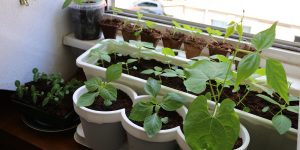
PLA(N)Tform – Growing, Sensing and Making Kin-Ship
Virtual BioSensing project group
Online exhibition of artistic biosensing experiments in virtual space and at BioDesign Lab HfG Karlsruhe

WATER (Hexa)
Claudia Müller & Matías Labbé (CL)
This axis exhibits a project developed by artists Claudia Müller and Matías Labbé, with glaciologist Francisco Aguirre and biologist Héctor Ortiz. Through images and sound, Hexa materializes a selection of data related to the retreat of the Schiaparelli Glacier, located in the Magallanes Region, such as fluctuations in energy, changes in water level, and speed of the ice flow.

EARTH (Nebula)
Mauricio Lacrampette (CL), Sebastián Arriagada (CL)
This axis is represented by KMNCHK ScanLab, a landscape laboratory directed by Mauricio Lacrampette dedicated to exploring the camanchaca: a characteristic coastal fog of the northern dry region of Chile. The project presents fog-scans where the motile traces of water droplets become manifest, visualizing air turbulence and unveiling the dynamic, chaotic and ever-changing inner geometry of the cloud.
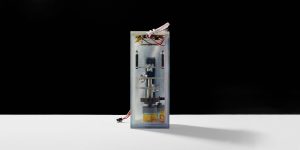
SPACE (Cosmoecology)
Luis Guzmán (CL)
This axis presents an art and science project by Luis Guzmán which consists of taking Phaeodactylum tricornutum diatoms (microalgae) to the International Space Station and subjecting them to Martian microgravity and zero gravity. The project has been part of Sojourner 2020 (MIT), the first ultraterrestrial museum of post- human art. In PRISMA´s garden, the artist presents the outcomes of his research after the Sojourner experience.
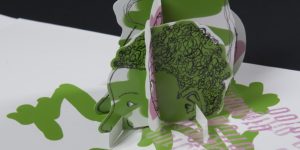
Die Menschine
Kommhaus (AT)
Die Menschine ist ein Buch über die Verbindung und Verschmelzung von Mensch und Maschine. Renommierte Experten verschiedener Disziplinen beleuchten in Texten Themen wie Digitalisierung, Vernetzung, Robotik, Künstliche Intelligenz, industrielle Revolution und Industrie 4.0.

The Role of Curator in the Digital Space
CADAF (The Contemporary and Digital Art Fair) (US)
This panel focuses on the various aspects of this complex medium including creation, collecting and exhibiting. Some of the mediums discussed include Artificial Intelligence, Blockchain and others.

Cairo is Data
Cairotronica (EG)
A film that shows Egypt through the eyes of 6 emerging new media artists sharing their grounds for inspiration. Their works that they are currently developing navigate the peculiarities, tensions and challenges that come at the intersection of technology, business, culture, and society.
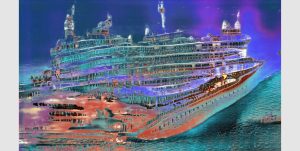
Artificial Seascapes. Two female AI artists respond to current uncertainty with powerful art.
CADAF (The Contemporary and Digital Art Fair) (US)
An one-hour live session with artists, Anne Spalter and Sofia Crespo, in discussion. We will dive into their artistic practices, their use of AI, and the relationship between data, GAN and human perception.
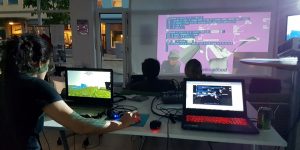
Live Coding ALGORAVE
Antonio Roberts, Alex McLean (UK)
Live performance at the Piksel Cyber Salon and Twitch Live coding is a performance practice that revolves around the real-time creation and modification of code and algorithms. These events are also known as ALGORAVE, by joining the words algorithm and rave. On 13 September, we welcome artists Antonio Roberts and Alex McLean and their live audiovisual performance, taking place in parallel at the Twitch Pikselfest and the Piksel Cyber Salon.
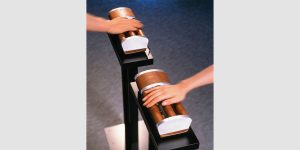
Presence of Absence: Guided Tour & Demo
by Prof. Hiroshi Ishii, Liang Zhipeng
We will host a live talk featuring some selected projects inside Tangible Media Group | MIT MediaLab in Cambridge, Massachusetts. In the end audiences are invited to have an open conversation with us.
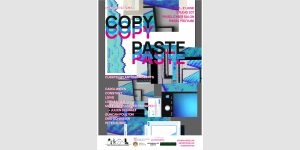
COPY PASTE Curator's Tour
Antonio Roberts (UK)
Video recorded lecture with Q&A from the curator Antonio Roberts will guide us through each work at the Piksel Cyber Salon exhibition. If you are an artist, then you have no doubt copied the work of others. This copying can range from using pages from a magazine in a collage to adopting the style of another artist, or simply being inspired by their work. This natural process of copying, taught to us at every stage of our artistic development, is burdened with a very complex and messy set of laws and social conventions which define and limit how we can use copying in our practices. They don't account for exceptions or nuances, and come from a historical world in which artworks were scarce physical objects, not translating well into a world in which culture is abundant and can be accessed and copied at will.
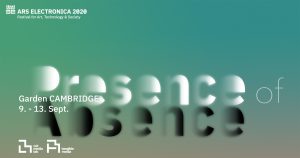
Presence of Absence: Garden
We will host an online garden to explore the “Presence of Absence.” Students and Professor Ishii from Tangible Media Group | MIT MediaLab will guide you through the future of Tangible Telepresence and Radical Atoms.

Artificial Seascapes
CADAF (The Contemporary and Digital Art Fair) (US)
Artificial Seascapes reflects on the impact humans and technology have on the environment and explores new ways to visualize it. By incorporating artificial intelligence, algorithmic tools and data processing into their practice, Spalter and Crespo allow us to see mundane events from the perspective of a machine. By shifting the focal point, scenes that are familiar to the human eye - cruise ship images or sea creatures - begin to evolve, resulting in new compositions that have never been seen. The artists invite the viewers to submerge in these new worlds, where beauty and technology collide to expose questions of human perspective, consciousness and preservation.

Digital Exhibition Sojourner 2020 – A conversation among all artists
Through the ages, artists, writers, and filmmakers have been inspired by space. Their visionary depictions of space as an environment for people have influenced the scientific and engineering feats we know so well today. How will artists continue to inspire the future of space exploration? What are the opportunities and challenges in the creation of art for our interplanetary futures?


